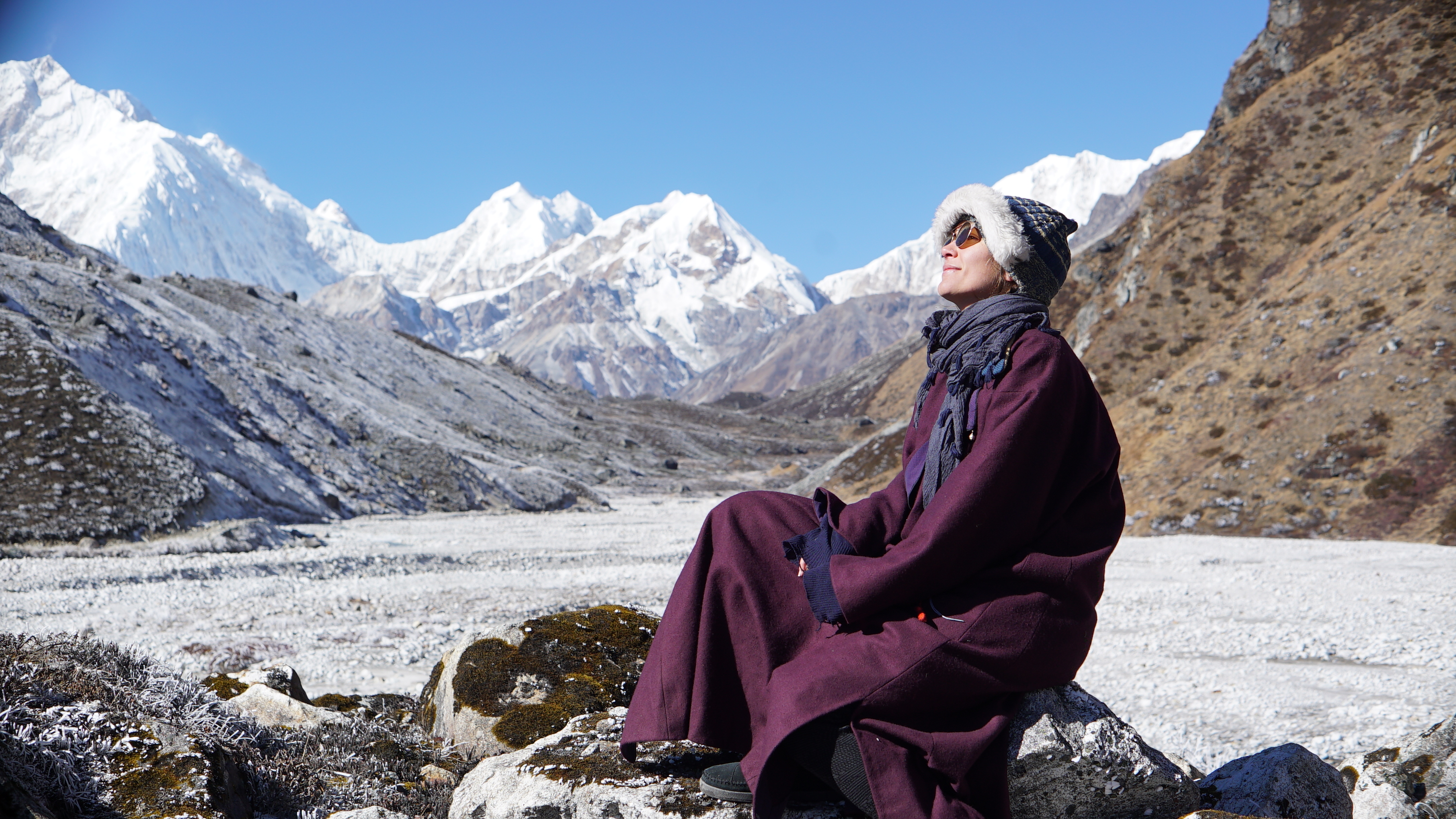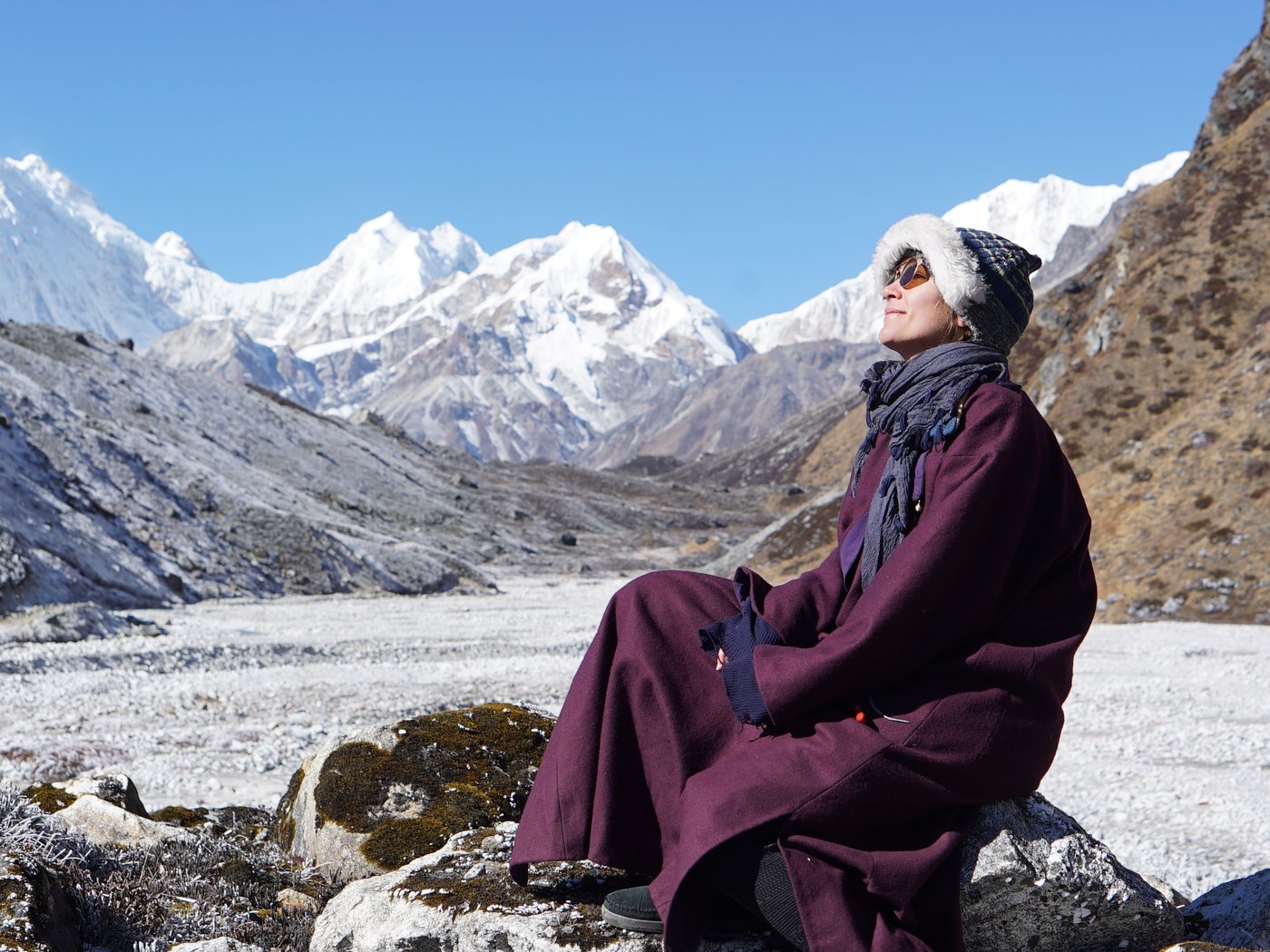Elise Wortley pulled her yak wool coat tight around her as the mountain temperature dropped to minus 10 degrees Fahrenheit. The fire at her feet flickered underneath her Himalayan rubber-soled shoes. Her canvas tent sat empty, apart from her homemade wooden backpack, as she couldn’t bear to peel herself away from the only source of heat for miles. This is where the 27-year-old slept, until the sun rose and she and her Lepcha mountain guide continued their trek up to the base camp of Kanchenjunga, the third highest mountain in the world, in November 2017.
It was another woman that brought Wortley to this point, the French explorer Alexandra David-Néel, who traveled through the Himalayas in the early 1900s. Wortley’s own journey through the Himalayas would become part of a six-year Woman with Altitude project that has seen her trace the routes of early female adventurers from the wilds of Scotland to the valleys of Iran.
Wortley’s vision began 11 years earlier, when at the age of 16 she first came across David-Néel’s 1927 book My Journey to Lhasa. The teenager from Essex in the U.K. was swept away with the tale of the French woman, who left her husband for a journey across the Himalayas that she said would take 18 months but ultimately kept her away for 14 years. The spiritualist, writer and anarchist meditated in a cave for two years, disguised herself as an old Tibetan woman to enter Lhasa, Tibet (which at the time was off-limits to foreigners), and battled hypothermia in the wild.
David-Néel is a very polarizing figure, explains Marion Dapsance, author of Alexandra David-Néel: Spiritual Icon, Feminist, Anarchist. She’s been criticized for traveling to Tibet to learn Buddhism and then dismissing it as superstition. But the opera-singer-turned-explorer caught people’s attention in her own time. “Her book My Journey to Lhasa established her as a celebrity in Europe,” says Dapsance. “She was a courageous woman with a strong will. People would find her strange and unusual, that’s for sure.”
The French explorer’s travelogue was only 290 pages. “I remember thinking, wow, she has condensed her story into this, but this journey was so much more than that,” says Wortley. The highlights in the book were enough to capture the 16-year-old’s imagination. The book stayed with her, and curious, she returned to it in her mid-20s, with a bold plan to discover what the female explorer had left out.
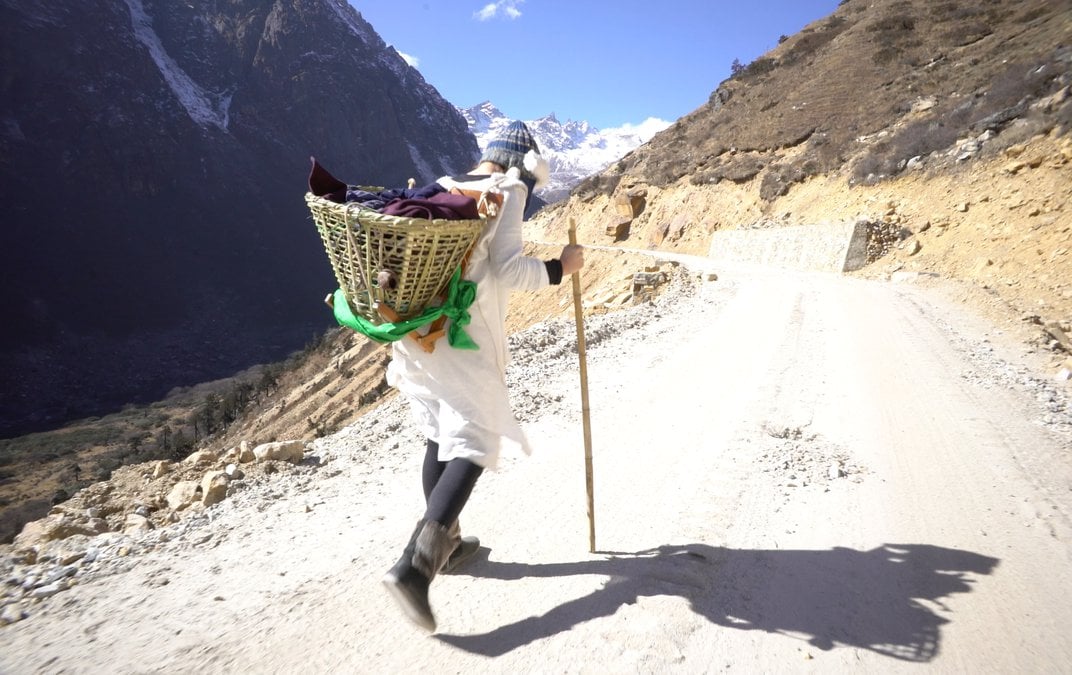
Wortley took six months to plan her expedition, a month-long, 108-mile hike from Lachen, in Sikkim, India, to Kanchenjunga base camp that replicated the last leg of David-Néel’s journey. Working in the marketing department for a travel company, Wortley had previously joined treks in Spain, but this expedition through the Himalayas would challenge her like never before. Plus, she was convinced that to really put herself in David-Néel’s shoes, she had to wear the same clothes that the 20th-century explorer wore.
“I thought that I can’t show how difficult this journey was or what she actually managed to achieve if I’m in modern expedition gear,” says Wortley. “However, finding that old equipment was really difficult.”
A friend in Nepal found a yak coat and rubber soled shoes for her to wear. Wortley found wooden backpacks from the 1900s on eBay, but as they didn’t come cheap, she decided to fashion a similar backpack from a discarded kitchen chair. Taking this step would bring Wortley closer to early female explorers than she might have realized.
“A lot of the clothing for early explorers was homemade as there wasn’t customized sportswear,” says Kate Strasdin, a fashion historian at Falmouth University in the U.K. “If you look in early periodicals, you will see people asking if anyone has a good recipe for waterproofing cloaks.”
Early female adventurers adopted clever strategies for dressing themselves for the elements. “Cords were sewn into the inside of their skirts, so they could raise them a bit like a Roman blind when they were climbing,” Strasdin adds. “One explorer, after climbing snowy slopes, used to tuck her skirts underneath her and use it like a toboggan.”
Wortley trekked from Lachen, India, through the snow-covered, rocky countryside to the base camp of 28,169-foot-tall Kanchenjunga. She and her team walked eight hours each day, but progress was slow. The journey from 8,530 feet to 16,404 feet took Wortley, her mountain guide Jangu Lepcha and her camerawoman Emily Almond Barr a month. The expedition team battled sub-freezing temperatures, skin rashes from wool layers and altitude sickness.
“I was thinking to do this back then with no satellite phone, no way out if anything went wrong, how brave you have to be to do that,” says Wortley. “Also, to withstand those temperatures and to keep going.”
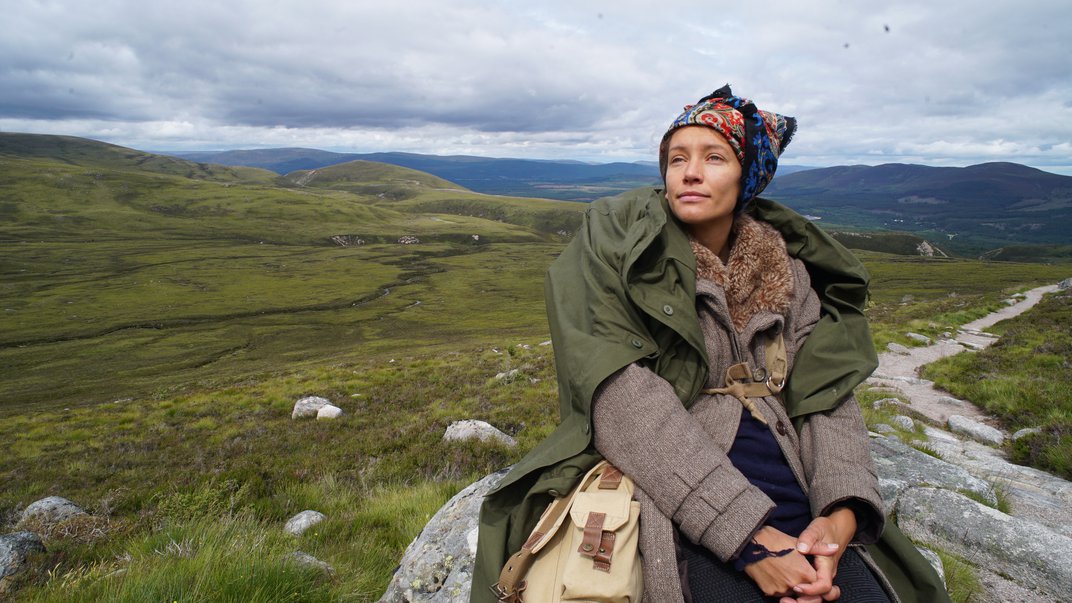
When Wortley arrived home to the U.K., she knew that she didn’t want this to be her last adventure. She didn’t have to look far for more inspiration, because on her return her mother presented her with a copy of The Living Mountain by writer and poet Nan Shepherd, who can now be seen on the Scottish five pound note. In the exemplar piece of nature writing, Shepherd describes her time trekking through the Cairngorms in the 1940s.
“It is certainly not about racing to the top of the mountain,” says Alison Lumsden, a professor of English literature at the University of Aberdeen. “She encourages us to look at detail, the shapes of rocks, the structure of a flower. There is a sense in which through this she suggests we come to know ourselves better, too.”
The book emboldened Wortley to spend June 2019 walking across the granite crags of the Scottish Highlands in a cotton dress and hobnail boots, shedding her clothing to swim naked in an icy Scottish loch like the adventurer had done. She slept in a canvas tent that she bought from eBay, and lived as Shepherd did off wartime rations, such as potatoes and small pieces of chocolate. As Shepherd wandered, Wortley did the same. “My plan for that was to go through the book and find the places that she wrote about,” says Wortley. “I kind of made my own route.”
Wortley paid for the Nan Shepherd trip herself, but as she made more plans and her Woman with Altitude Facebook page, which she started in September 2017, attracted attention, she gained sponsors. Companies such as Intrepid Travel and the North Face have provided kit to her camerawoman and guide.
When it comes to planning her trips, Wortley searches the internet for inspiring stories of early female explorers that align with countries where she has always wanted to go.
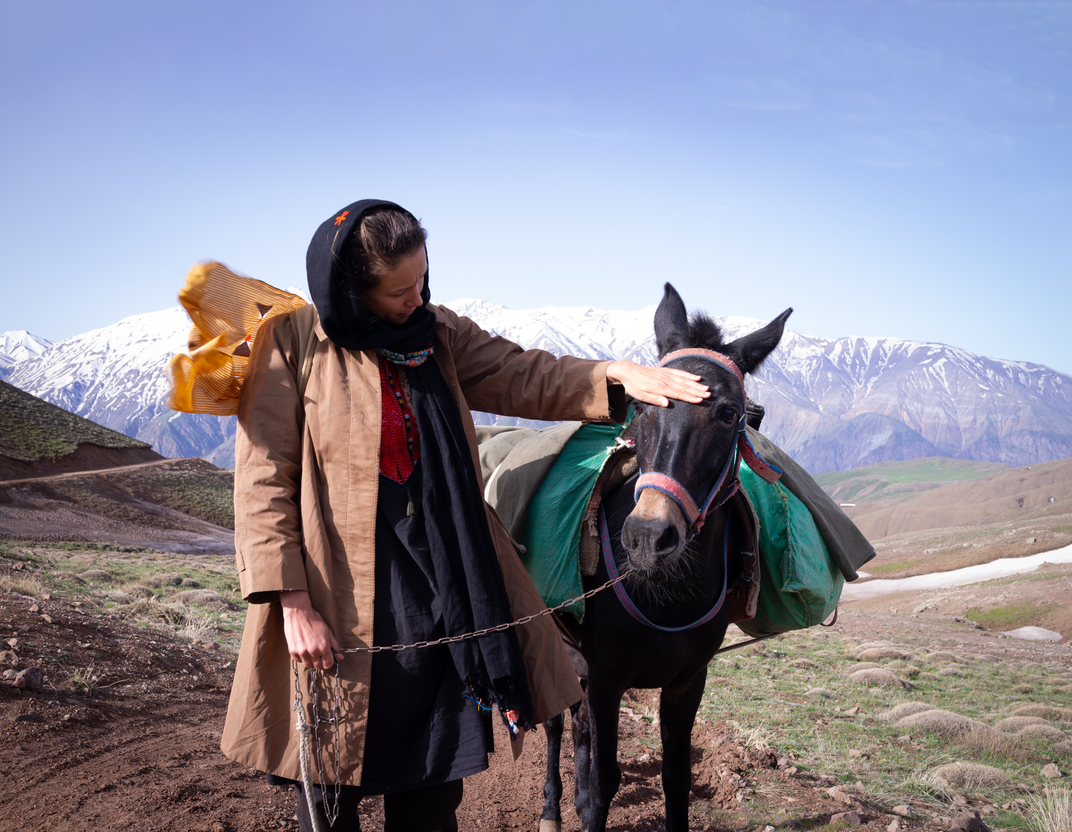
In spring 2022, Wortley followed in the footsteps of British-Italian explorer Freya Stark, who in the 1930s trekked through the Valley of the Assassins in Iran. With just two pounds in her pocket and a mule to carry her luggage, Stark, a cartographer, went into the desert to find the mountain hideouts of an ancient sect that famously kept the Mongols at bay for more than 200 years.
“Freya Stark would completely immerse herself in the cultures she visited. That was quite important for me as well,” says Wortley. “For a lot of the male explorers at that time, their main aim was to be the first to get there and get all the glory. But she was really involved.”
Wortley drove five hours from Tehran to the Alborz Mountains, and wearing a 1930s Burberry mac and a new pair of hobnail boots, trekked for three weeks through the desert mountainside, walking between villages, where she would stay with Iranian families.
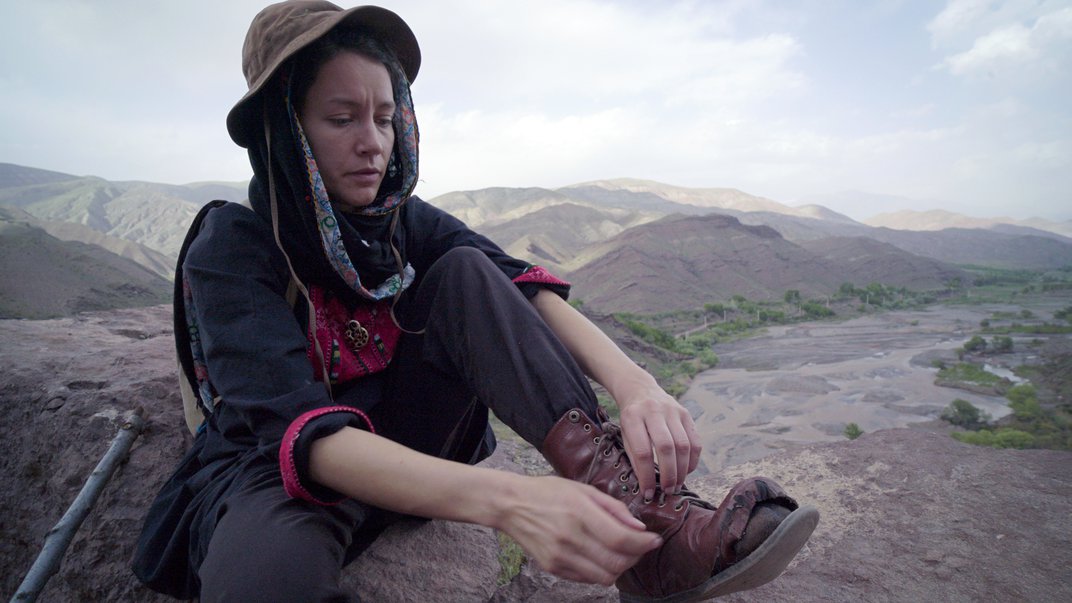
“The paths were shepherds’ paths, really narrow and steep, so my hobnail boots got completely destroyed,” says Wortley. “I woke up one morning and there was this group of people from the village gathered around my broken boot. They felt so sorry for me, and they were busy sewing it up. It was amazing and lasted for the rest of the trip.”
Next, during the summer of 2022, Wortley retraced the path of Scottish climber Jane Inglis Clark, the first women to climb Ben Nevis, the tallest mountain in the British Isles. Wearing hobnail boots with heels and tweed as Clark did in 1897, Wortley scrambled up part of the rock face of the 4,411 foot mountain. Thinking about her predecessor left her in awe. “She was the first recorded woman to climb Ben Nevis on all the different sides,” says Wortley. “She was just a really cool bad ass woman.”
After being barred from the men-only Scottish Climbing Club, Clark cofounded the Ladies Scottish Climbing Club, which now has 120 members and is the oldest active climbing club exclusively for women. “They [early club members] were looking for adventure and to push the boundaries of what was considered acceptable for women of that age to do,” says Lis Cook, the club’s honorary secretary. “They were pioneers.”
After six years following in the footsteps of early female explorers, Wortley’s wanderlust has only grown. The 33-year-old now has a wish list of 150 expeditions she’d like to take, all reliving the exploits of past adventurers.
“Some are more possible to do than others,” says Wortley. “There is Bessie Coleman who was the first woman of African American and Native American descent to earn her pilot’s licence in the U.S., who was famous for doing loop-the-loops. One thing I’d like to do is get a vintage plane and someone to teach me how to do loop-the-loops.”
But for now, the modern adventurer plans to bike across Sri Lanka to celebrate the journey of Annie Londonderry, who circumnavigated the globe by bicycle, leaving Massachusetts State House in Boston in June 1894, with a pearl-handled pistol in her pocket (though that’s one addition Wortley is sure to leave out of her suitcase). “I’m trying to get a bike from the 1800s,” Wortley says. “I might have to get it made.”
Wortley is also planning to sail across the Irish Sea in the wake of 16th-century pirate Grace O’Malley, who journeyed from Ireland to England to petition Queen Elizabeth I for the release of her son in September 1593.
“First, I would love to dress like a 16th-century pirate,” laughs Wortley. “But I would love to bring together a group of women and an old gully boat and row from west Ireland to Greenwich.”
Wortley hopes these explorers will inspire others just as David-Néel inspired her. “If I can keep sharing their stories, women or men will read all about it and think maybe I can do that one thing I’ve always wanted to do,” says Wortley.
